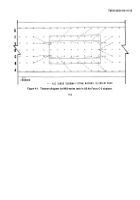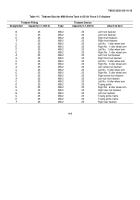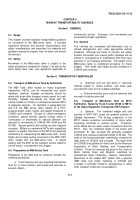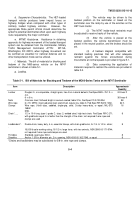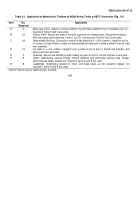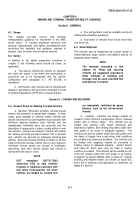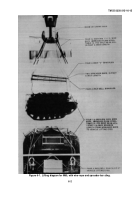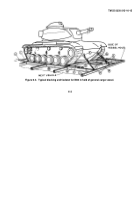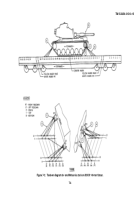TM-55-2350-215-10-15 - Page 36 of 66
TM 55-2350-215-10-15
Table 6-1.
Bill of Materials for Blocking and Tiedown of M60 in Hold of General Cargo Vessel (Fig.
6-2)
Item
Description
Approximate
quantity
Lumber
Douglas-fir, or comparable, straight-grain, free from material defects; Fed Spec
MM-L-751c:
4- x 6 in.
.........................................................................................
4
linear ft
2- x 12-in .
......................................................................................
80
linear ft
6- x 8-in .
........................................................................................
154 linear ft
Nails
Common, steel; flathead; bright or cement-coated; table Xl-b, Fed Spec FF-N-105a:
20d .
..................................................................................................................
20
40d .
..................................................................................................................
116
Wire
rope.
.....
6 x 19, IWRC; improved plow steel; preformed, regular-lay; table X, Fed Spec RR-W-
410a:
60 ft
5/8-in
Clamps.
.....
Wire-rope, "U"-bolt clips, single-grip, steel, Crosby heavy-duty, or equal; MIL-STD
16842:
16
5/8-in.
Shackles.
....
Clevis assembly suspension, bolt and nut type, large, FSN 1670-090-5354, or equal (for
4
front and rear towing and tiedown provisions).
Table 6-2. Application of Materials for Blocking and Tiedown of M60 in Hold of General Cargo Vessel (Fig. 6-2)
Item
No.
Required
Application
A
4
Lumber, 2- x 12- x 240-inch.
Pre-position on vessel hold floor under vehicle treads; two
pieces required under each tread.
B
2
Side blocking.
Each consists of one piece of 6- x 8- x 240-inch lumber.
Locate against
vehicle treads; one piece on each side of vehicle.
C
2
End blocking.
Each consists of one piece of 6- x 8-in.
x length-to-suit.
Locate on top of
item B against vehicle treads.
Toenail to item B with four 40d nails at each end.
D
4
Backup cleats, 4- x 6- x 12-inch lumber.
Locate on top of item B against item C.
Toenail
to item B with four 40d nails.
E
4
Shackles.
Secure one shackle to each towing lug (two at front and two at rear end of vehicle).
F
4
Wire rope, 5/8-in., in a complete loop.
Secure with clamps (item G).
Attach to front and rear
shackles and padeyes.
G
16
Clamps, 5/8-in.
Secure to item E in complete loop.
H
4
Padeye.
Four required on floor of vessel.
J
as required
Bracing, 6- x 8in.
x length-to-suit.
Brace as required against vehicle blocking, side of vessel,
or adjacent cargo blocking to immobilize vehicle and blocking.
Secure each end to
adjacent bracing or blocking detail by toenailing with four 40d nails.
c.
Special Design
.
Seatrain trailer vessels, roll-
on/roll-off vessels, landing ships, and attack-cargo
vessels are all equipped with patented lashing gear and
pre-positioned fittings in the deck.
By proper application
of four 70,000-lb (31 752 kg) or eight 35,000-lb (15 876
kg) lashing gear to each end, the M60 will not require
blocking and bracing.
Typical application of patented
lashing gear securing M60-series tanks is shown in
figure 6-3.
6-5.
Barges and Lighters
When the vehicle is moved by barge or similar
lighterage to or from vessels secured to piers or at a
sheltered anchorage, blocking and bracing materials will
be required.
When the vehicle is moved for extended
distances or through rough waters, tiedowns must also
be used.
6-6.
Landing Ships, Landing Craft, and Amphibious
Vehicles
When the vehicle is moved for extended distances or
through rough waters, blocking and tiedowns must be
used.
In most cases, the vessels are equipped with
turnbuckles with a sheep's foot on one end that fits into
a deck cloverleaf; where turnbuckles are not provided, a
suitable substitute may be used.
6-7.
Lighter Aboard Ship (LASH)
a.
General
.
To transport the vehicle by LASH-
type ships, securement by blocking and tiedown
requirements is essential, as illustrated in figure 6-4.
(1)
Armored tracked vehicles may arrive at
the processing area with access hatches or tank turrets
welded shut to prevent pilferage.
Since these vehicles
are not maneuverable under their
6-4
Back to Top

